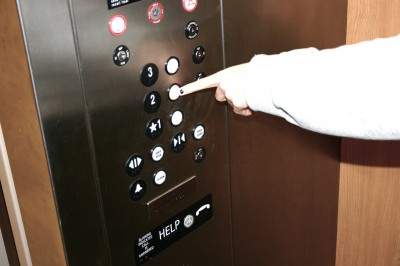Dana Rappaport ’11
Web Opinions Editor

To some, the Staples elevator is a free ride that provides leisurely access to different floors and is accessible at the push of a button.
It is truly a peculiar phenomenon that students are not rushing into the crammed area in order to avoid the agonizing trip of walking up a flight of stairs.
Students Who Use Elevators
The elevator is open to any students who have received a note from a physician, directly stating that they cannot use the stairs – such as students in a medical boot or on crutches. The elevator is also open to students who have permanent disabilities such as being in wheelchair.
“I cannot walk up stairs because I tore my ACL snowboarding” said Jack Roof ’13, a current elevator user.
Roof admits that the elevator has created easier access—due to his inability to successfully walk ups stairs—around the school.
The elevator is also open to all teachers, and there are no restrictions on staff that can or cannot take it.
Students with access to the elevator, too, are allowed to leave class five minutes before passing time. This allows the injured student not to get bunched up in the rush between classes.
“Even with the five extra minutes I was sometimes late to class. My teachers were very understanding, and did not have any problems with me leaving early either” said Mel Rubin ’10 who suffered from a stress fracture in her tibia earlier this year.
In addition to leaving class early, the student is allowed to bring one peer with them in case they are in need of help with carrying their bags.
The Downside of Elevator Use
Although the elevator may seem like a fun way to get to class, students agree that there definitely are faults with it.
“I do not think that the elevator is very beneficial because it’s slow” said Emily Eisenberg ’12.
Eisenberg uses the elevator because she has damaged her ACL and cannot walk up stairs. Eisenberg has had to wait several minutes, even after she has left class early, for the elevator to come to her floor and open. She believes that if the school makes the elevator faster, then she will be able to get to class on time.
Other students not only dislike the speed of the elevator, but the location as well.
“It is hard to get to classes at the end of the hallway from the elevator” said Stephan Patterson ’12, who uses the elevator a good amount due to his injury.
Across the board, it may seem that the infamous elevator is overrated in terms of its accessibility for students.
Inappropriate Elevator Use
No major problems with elevator misuse have risen within the student body; however that does not out rule the actuality that many students use the elevator who are not supposed to.
“Sometimes I’ll use the elevator when I have to get to the third floor during the first period of the day and I’m just too sore from sports, a student, who requested anonymity said.
The student continued to say that students are always jumping in the elevator last minute with their injured friend, just as an excuse to ride it.
“Kids cannot make the determining factor of if they need to use the elevator or not. We make these rules because the students need exercise! It’s good for them to use the stairs,” school nurse Libby Russ said.
Even injured students who necessitate elevator use admit that the stairs would be a much faster mean of transportation to class.
Elevating Consequences
What are the consequences to those who “illegally” provide themselves with a free ride to class?
On page 39 of the Staples handbook, it is specifically stated that if students engage in a behavior “in an unauthorized area,” then they can be subject to a warning.
“If students are caught who are not supposed to be using it they get an earful from administrators,” said Patrick Micinilio, the assistant principal for the class of 2013.
If the behavior continues, and the student is caught—yet again—they could find themselves receiving one monitored study, one detention, or one day in-school suspension.
Micinilio asserted that the administrators could be more consistent with stopping students who should not be using the device; however no major problems have occurred that have required major enforcement to be used.
Overall the elevator is a generous commodity our school has to offer to those in need. However, for such a large school maybe the addition of another elevator would increase the speed at which students could get to class and accessibility.














































Meetali makhija • Jul 20, 2019 at 8:16 am
I am 36 years old female started working in a reputed school in Bangalore india.their was a lift but teachers were not allowed to use the lift.climbing up staircase 4-5 times a day that too 3-4 floors damaged my back my knees.it started paining alot but their was no provision for it’s usage.i want to know was it correct.? Because of this I had to left my job.
rorryanne • May 7, 2019 at 4:06 am
can your elevator key get taken if you got a permanent disability from letting more than one kid on?
Olddantrucker • Mar 7, 2019 at 11:12 am
though it’s not hard to get an elevator key from common internet sites U Bay (I Won’t mention it’s real name but I’m sure you know) anyways which while a student can gain an illegal key doing so can be useful to schools who lose one?
Olddantrucker • Mar 7, 2019 at 11:09 am
Problem is after PE people are sore. Those who are in attendance should be allowed a elevator pass from the PE(u) teacher on a case by case basis perhaps with a refundable deposit for missing keys.